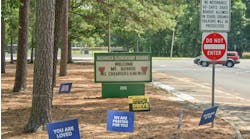This fall, the Los Angeles Unified School District sold about $2 billion in bonds to finance more projects in its massive school construction program. But the cost of repaying that debt won't be as burdensome as it could have been.
Los Angeles took advantage of two federal programs available to school systems through the American Reinvestment and Recovery Act — Qualified School Construction Bonds (QSCB) and Build America Bonds. The bonds issued through those programs offer tax credits that reduce a borrower's interest costs. For someone borrowing $2 billion, the savings can be substantial. The Los Angeles district estimates that it will save $648 million as it pays off those bonds in the coming years.
The numbers aren't always as eye-popping as the billions available through those bond programs, but the Recovery Act has included many ways for schools and universities to lay claim to federal funds to help build, renovate or maintain their facilities. Here are 10 federal stimulus programs that offer education institutions an opportunity to upgrade their infrastructure and stimulate the economy:
QUALIFIED SCHOOL CONSTRUCTION BONDS
This program is the part of the stimulus act that has provided the greatest amount of direct federal assistance for education facilities. These bonds provide tax credits that enable school systems to construct facilities without having to pay interest on the bonds. That makes it affordable for school districts such as Detroit to borrow the money to rebuild aging facilities. A $500 million bond proposal approved in November by voters in the Detroit school district includes $246 million in QSCBs. In the Clark County (Nev.) school district, officials will use $104 million in QSCBs to carry out already approved construction projects whose funding was in jeopardy because of declining sales tax revenues and state budget cuts. The Recovery Act authorized $11 billion in bonds for 2009 and the same amount in 2010.
BUILD AMERICA BONDS
Under this program, which can be used for education facilities as well as other public infrastructure projects, the federal government provides a subsidy for 35 percent of the interest costs for bonds issued by state or local government entities. About $1.4 billion of the Los Angeles district's $2 billion bond sale in October were Build America Bonds, and $254 million of November's Detroit school bond proposal will be Build America Bonds.
BUREAU OF INDIAN AFFAIRS
The federal stimulus package included $277 million for replacing or repairing school facilities that are under the auspices of the Bureau of Indian Affairs. One project to benefit from the funding is the Rough Rock Community School on the Navajo Reservation in northeastern Arizona. The K-12 school, which opened in 1966 and serves about 440 students in day and residential programs, needs significant facility upgrades.
The bureau has allocated $52.5 million to carry out two phases of upgrades at the school. The first phase calls for constructing a replacement student residence for grades K to 8. The second phase will replace a K-8 academic building and two student residence halls.
Other school facilities slated for replacement include Crow Creek Tribal School in Stephan, S.D., and the Pueblo Pintado Community School in Cuba, N.M.
NATIONAL INSTITUTE OF STANDARDS AND TECHNOLOGY (NIST)
Higher-education institutions and non-profit organizations will find out in early 2010 whether they will receive grants from the National Institute of Standards and Technology for the construction of new or expanded scientific research buildings. As part of the federal economic stimulus, NIST plans to award about $120 million, which will help pay for eight to 12 projects. Possible projects, the institute says, include laboratories, test facilities, measurement facilities, research computing facilities and observatories.
In addition, the stimulus package enabled NIST to award $55.5 million in grants for four construction projects that previously were approved, but unfunded. The University of Miami received $15 million to help pay for a $43 million Marine Technology and Life Sciences Seawater Research Building; Auburn University in Auburn, Ala., got $14.4 million to cover half the cost of building a Center for Advanced Science, Innovation and Commerce; Rice University in Houston was awarded $11.1 million to help pay for a $44 million Brockman Hall for Physics; and the University of North Carolina, Wilmington received $15 million to build a $30 million facility for the Marine Biotechnology in North Carolina program.
RACE TO THE TOP
The stimulus package has put $4 billion in competitive grant funds in the hands of U.S. Education Secretary Arne Duncan. The education department says Duncan will award the grants to states that have "raised student performance in the past and have the capacity to accelerate achievement gains with innovative reforms."
"We will award grants to the states that have led the way in reform and will show the way for the rest of the country to follow," says Duncan.
The education department notes that to qualify for Race to the Top funds, states must have no legal barriers to linking student growth and achievement data to teachers and principals for the purposes of evaluation. This has prompted states such as California to work on legislation that will remove those barriers in their regulations. Some states with a record of indifference or hostility to reforms such as charter schools are reconsidering their stance so they can have a better chance at receiving the grant funds.
U.S. Education Department officials hope to announce the first of the Race to the Top grants in Spring 2010.
RESEARCH FACILITIES
The National Center for Research Resources, part of the National Institutes of Health, has received $1 billion in stimulus funds that it will award through a grant program to higher-education institutions for renovating, repairing or improving their core facilities for biomedical or behavioral research. In another program, "Academic Research Infrastructure Program: Recovery and Reinvestment," the National Science Foundation (NSF) will award $200 million in grants to update existing research facilities at institutions of higher education and other non-profit research organizations.
"In 2005, NSF estimated that academic institutions had at least $3.6 billion in deferred projects to repair and renovate science and engineering research facilities," the grant summary states. "This investment will advance the science and engineering research enterprise at many institutions."
QUALIFIED ZONE ACADEMY BONDS
The Recovery Act included $2.8 billion in funding ($1.4 billion in 2009 and $1.4 billion in 2010) for this program. Schools or districts that have 35 percent or more of their students eligible for free or reduced-price lunches can issue zero-interest bonds. They cannot be used for constructing new schools, but they can be used for school renovations, equipment and technology upgrades, teacher training and curriculum development
LUNCH PROGRAM EQUIPMENT
As part of the stimulus package, the U.S. Department of Agriculture allocated $100 million to states, which issued grants to help schools improve their equipment for providing school lunches. Priority was given to schools in which at least 50 percent of the students are eligible for free or reduced-priced meals. The equipment purchased had to meet one of the following goals: improves the quality of school food-service meals that meet the dietary guidelines. (e.g., purchasing an equipment alternative to a deep fryer); improves the safety of food served (e.g., cold/hot holding equipment); improves the energy efficiency of the school food-service operations; and expands participation in a school meal program.
QUALIFIED ENERGY CONSERVATION BONDS
The stimulus package allocated $3.2 billion for this program. It provides tax credits for capital projects that reduce energy consumption in a public building, including schools and universities, by 20 percent. In addition, the U.S. Department of Energy has energy-efficiency block grants and a State Energy Program for which schools and universities may be eligible. In July, the Energy Department awarded Texas $87.5 million through the State Energy Program. Texas will use some of that allocation for grants to state agencies, communities, schools and hospitals "to install and demonstrate solar, wind, biomass, and geothermal energy technologies," the energy department says.
RURAL COMMUNITY FACILITIES PROGRAM
Schools and colleges are eligible to apply for $1.1 billion in loans and $61 million in grants for constructing or upgrading facilities. Woodstock Academy in Woodstock, Conn., received $1.4 million through the program to install a sewer line to connect the school to the public sewer system. The program provided the McFarland Unified School District in Kern County, Calif., with a $29,700 grant to buy security cameras.
Kennedy, staff writer, can be reached at [email protected].

